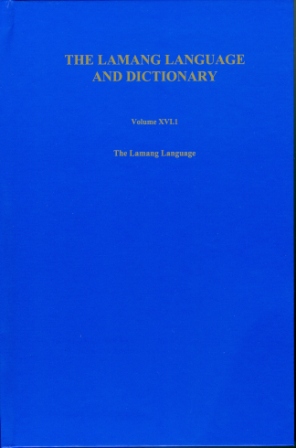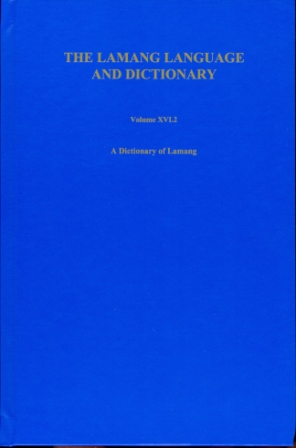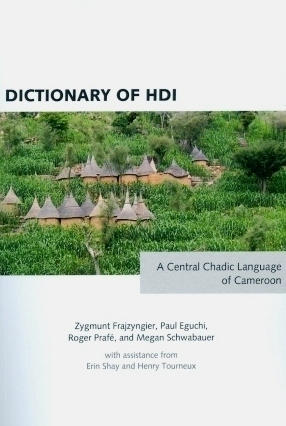


The Lamang Language and Dictionary
Documenting Gwàɗ Làmàŋ – Endangered Central Chadic Language in Northeastern Nigeria. Volume 1 and 2
Author: H. Ekkehard Wolff. Series founded by: Johannes Lukas †. Series edited by: Hilke Meyer-Bahlburg, H. Ekkehard Wolff.
Series: AFO Afrikanistische Forschungen Volume XVI
20151110 pp.
17 figures, numerous tables, 2 volumes
Format: 160 x 240 mm
2380 g
Hardcover
€ 138.00
Order 'The Lamang Language and Dictionary' as print edition »
The two volumes of The Lamang Language and Dictionary complete a long-term documentation project on this Chadic language which is spoken in north-eastern Nigeria’s Borno and Adamawa States. The author began the research project in the late 1960s and continued to work on it, intermittently and with long periods of inactivity, until early 2014. The language belongs to the Central (also called Biu-Mandara) branch of the Chadic language family, which in turn is part of the Afroasiatic macro-family of languages.
Based on figures of 1993, the population of speakers is given as 40,000 (www.ethnologue.com) but may be considerably higher by now. Its sociolinguistic status in terms of language vitality or endangerment is described as vigorous, meaning that the language is used for face-to-face communication by all generations and the situation is sustainable. With the two part volumes, a rich and linguistically exciting human language has been comprehensively documented and is thus saved from oblivion – hopefully also for a more immediate benefit to its speakers.
Volume XVI.1 is a revised descriptive grammar with some elements of Lamang-Hdi comparative phonology and grammar (Chapter 3) and a comparative lexicon (Chapter 4). Hdi is Lamang’s closest sister language, spoken in and around Tourou (Turu) in adjacent parts of northern Cameroon.
Volume XVI.2 contains a comprehensive Lamang-English dictionary based on the rich language corpus of natural discourse which was recorded in linguistic fieldwork between 1968 and 1974 and 1980-1982. It is complemented, in a second part, by an English-Lamang Reference List to identify corresponding lemmata in the dictionary.
In 1994, the author published traditions and specimens of oral literature from Gwàɗ Làmàŋ speaking peoples, titled Our People’s Own (Ina Làmàŋ). The edition features full texts, including English translations and annotations (see under additional material).
Both parts of this edition can be ordered separately, see the links at the bottom.
Under these links you will find further descriptions of Central Chadic / Biu-Mandara languages and cultures:
Accompanying material:
- Advances in Minority Language Research in Nigeria vol. I
(ISBN 978-3-89645-426-3 ) - Dictionary of Hdi
(ISBN 978-3-89645-299-3 ) - Dictionnaire Mofu-Gudur – Français – Fulfulde
(ISBN 978-3-89645-423-2 ) - Die Mafa im Spiegel ihrer oralen Literatur
(ISBN 978-3-89645-126-2 ) - Our People’s Own (Ina Lamang)
(ISBN 978-3-89645-290-0 ) - The Ways of the Mandara Mountains
(ISBN 978-3-89645-464-5 )
Cross-reference:
- Proceedings of the 2nd WOCAL World Congress of African Linguistics, Leipzig 1997
(ISBN 978-3-89645-124-8 ) - Proceedings of the 4th WOCAL World Congress of African Linguistics, New Brunswick 2003
(ISBN 978-3-89645-338-9 ) - The Lamang Language and Dictionary
(ISBN 978-3-89645-296-2 ) - The Lamang Language and Dictionary
(ISBN 978-3-89645-297-9 ) - Topics in Chadic Linguistics II
(ISBN 978-3-89645-522-2 ) - Topics in Chadic Linguistics III
Historical Studies
(ISBN 978-3-89645-523-9 ) - Topics in Chadic Linguistics IV
Comparative and Descriptive Studies
(ISBN 978-3-89645-524-6 ) - Topics in Chadic Linguistics IX
(ISBN 978-3-89645-529-1 ) - Topics in Chadic Linguistics VII
(ISBN 978-3-89645-527-7 )
Reviews
The Chadic language family is a branch of Afro-Asiatic, and embraces more than 150 languages, whose bibliography is quite rich for number of publications. Since more than half of these languages are not so well documented, we should be grateful to the author for this recent publication, which is the latest work on this language he started to study in the late 1960s (p. 7), with a project which continued intermittently until early 2014.
[...] one may say that the dictionary as well as the grammar does contribute in an excellent way our knowledge of this small language: Lamang, i.e. even more to be valued since the research conditions are presently not favourable in this border area of Nigeria and Cameroun. Hopefully the situation may change in order to shed more light on those Chadic languages spoken in this region.
Sergio Baldi in Orientalistische Literaturzeitung, 2017, 112/1, 92-93
| « back | Print version | [top] |
 Books
Books Audio
Audio Biographies
Biographies Series
Series Festschrifts
Festschrifts Journals
Journals